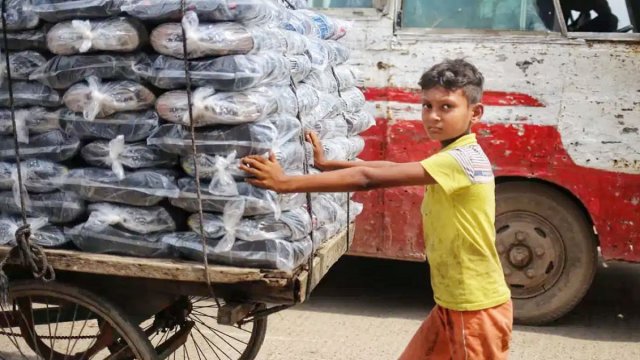Dainikshiksha Desk: Twelve-year-old Foysal came to Dhaka from Noakhali’s Chatkhil upazila this year and took a job at a metal workshop in the Kanthal Bagan area, looking to support his father to run their seven-member family.
Having left school after class V, he now works as a trainee in the workshop for 12 hours starting at 9:00am without payment but for food and free accommodation.
Another 16-year-old worker named Nirob joined the same workshop three years ago, also for food and lodging.
Foysal and Nirob are two of thousands of child labourers in Bangladesh who have taken jobs, mostly in Bangladesh’s informal sector, to skip poverty and are subject to many kinds of exploitation.
The National Child Labour Survey 2022, published by the Bangladesh Bureau of Statistics on March 14, 2024, revealed that there were 3.9 crore children aged 5–17 in 2022.
Of them, 35.3 lakh were working children, an increase from 34.5 lakh in 2013.
The survey defined all children below 18 years of age engaged in any activity to produce goods or to provide services for use by others or for their own use as working children.
The survey identified 17.8 lakh children as child labourers, with an average monthly income of Tk 6,675. Among the child labourers, 10.68 lakh are engaged in hazardous jobs.
The number of child labourers in Bangladesh was 16.98 lakh in 2013, including 12.80 lakh engaged in hazardous jobs.
The number of child workers has risen despite the government›s pledge to eliminate child labour in accordance with the Sustainable Development Goal aimed at ending all forms of child labour by 2025.
A separate survey titled ‘Establishment-based Sector-wise Working Children Survey-2023’, conducted by BBS in five out of 43 sectors declared hazardous by the government, found that 38,006 children, including 64.3 per cent living in urban areas, aged between 5 and 17 years, are working in automobile workshops, the leather shoe industry, welding or gas burner mechanic workshops, local tailoring or garment stitching, and dry fish production.
The survey shows that children, on average, work for 9.4 hours daily, with over half of establishments failing to comply with safety provisions, and less than half providing free food to children.
The Labour Act, 2006, prohibits the employment of children under 14 years old as well as hazardous forms of child labour for persons under 18.
As per the law, children between 5 and 11 years of age working for any period of time in a non-hazardous are all child labourers while children aged 12–17, inclusive, who work for more than 42 hours a week in a non-hazardous job are defined as child labourers.
The government has prepared a National Plan of Action to eliminate child labour by 2025.
Experts observed that the Covid-19 pandemic led to a surge in child labour as many students dropped out of school.
AKM Masud Ali, executive director of INCIDIN Bangladesh—an organisation working on child labour for 20 years—said that the government lacked area-specific and sector-specific data on child labour, a primary requirement to eliminate child labour.
‘The implementation of the government action plan is slow. Several private initiatives to eliminate child labour also went closed during the Covid-19 pandemic, making achieving the SDG goal difficult by 2025,’ he said.
Salma Ali, co-chair of the National Child Labour Monitoring Committee, attributed the rise in child labour to factors such as inadequate monitoring in factories and parents enlisting their children in labour due to poverty.
They resulted in increased exposure to physical, mental, and financial vulnerability among children, she said.
Julia Jesmin, joint inspector general of the Department of Inspection for Factories and Establishments, said that they do not have a specific inspection programme dedicated to addressing child labour.







